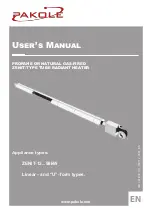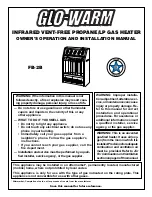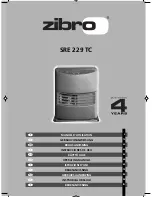
6 720 646 804
12
Installation instructions
Failing to install this accessory will void the tank
warranty.
3.4.3
Condensate Drain Tubes
This unit has a condensation tray. The water collected
in the tray drains out of the drain ports coming off the
back of the unit. Two flexible hoses are included with
this unit. It is important that both of these hoses are
attached to the two drain ports coming off the back of
the unit. The upper drain serves as an overflow drain
that will operate only if the bottom drain is blocked.
Water leaking from the upper drain is an indicator that
the lower drain, and possibly the condensate pan itself,
require cleaning.
B
Attach one end of the longer 6’ hose to the lower
drain port on the back of the unit, underneath the rear
cover.
B
Direct the other end to a drain in the floor or no higher
than 3’ above the floor.
If such drain is unavailable, a condensate drain pump
(not provided) must be purchased and installed.
B
Attach the shorter 3” hose to the top drain port.
Fig. 9
3.4.4
T&P Valve
A combination temperature and pressure-relief valve,
complying with the Standard for Relief Valves for Hot
Water Supply Systems, ANSI Z21.22, is supplied and
must remain installed in the opening provided and
marked for the purpose on the water heater. No valve of
any type should be installed between the relief valve and
the tank. Local codes shall govern the installation of
relief valves.
Connect the outlet of the relief valve to a suitable open
drain so that the discharge water cannot contact live
electrical parts or persons and to eliminate potential
water damage. Under no circumstances should the
relief valve vent be connected to the condensate drain
line.
Piping used should be of a type approved for hot water
distribution. The discharge line must be no smaller than
the outlet of the valve and must pitch downward from
the valve to allow complete drainage (by gravity) of the
relief valve and discharge line. The end of the discharge
line should not be threaded or concealed and should be
protected from freezing. No valve of any type, restric-
tion, reducing coupling or tee should be installed in the
discharge line.
This valve must be marked with a maximum set pressure
not to exceed the marked maximum working pressure of
the water heater. It should be installed into an opening
provided and marked for this purpose in the water
heater, and vented so that any discharge from the valve
exits only within 6 inches above, or at any distance
below, the structural floor, and does not contact any live
electrical part. The discharge opening must not be
blocked or reduced in size under any circumstances.
3.4.5
Thermal expansion tank
Determine if a check valve exists in the inlet water
supply line. It may have been installed in the cold water
line as a separate backflow preventer, or it may be part
of a pressure-reducing valve, water meter or water
softener. A check valve located in the cold water inlet
line can cause what is referred to as a "closed water
system". A cold water inlet line with no check valve or
backflow prevention device is referred to as an "open"
water system.
As water is heated, it expands in volume and creates an
increase in the pressure within the water system. This
action is referred to as "thermal expansion". In an
"open" water system, expanding water which exceeds
the capacity of the water heater flows back into the city
main where the pressure is easily dissipated.
A "closed water system", however, prevents the
expanding water from flowing back into the main supply
line, and the result of "thermal expansion" can create a
rapid and dangerous pressure increase in the water
heater and system piping. This rapid pressure increase
can quickly reach the safety setting of the relief valve,
causing it to operate during each heating cycle. Thermal
expansion, and the resulting rapid and repeated
expansion and contraction of components in the water
heater and piping system, can cause premature failure
Warning: To reduce the risk of
excessive pressures and temperatures
in this water heater, install temperature
and pressure protective equipment
required by local codes and no less
than a combination temperature and
pressure relief valve certified by a
nationally recognized testing laboratory
that maintains periodic inspection of
production of listed equipment or
materials, as meeting the requirements
for Relief Valves for Hot Water Supply
Systems, ANSI Z21.22.













































